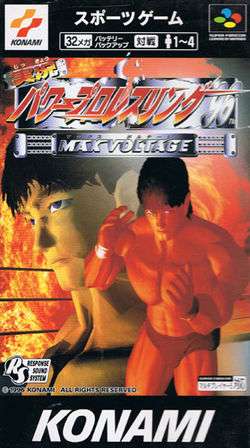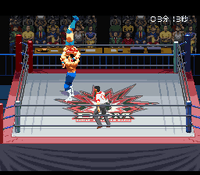Jikkyō Power Pro Wrestling '96: Max Voltage
| Jikkyō Power Pro Wrestling '96 Max Voltage | |
|---|---|
 Cover art | |
| Developer(s) | Diamond Head[1] |
| Publisher(s) | Konami[1][2] |
| Platform(s) | Super Famicom |
| Release date(s) | |
| Genre(s) | Wrestling[1][2] |
| Mode(s) |
Single-player Multiplayer |
Jikkyō Power Pro Wrestling '96: Max Voltage (実況パワープロレスリング'96 マックス ボルテージ Jikkyō Pawā Puro Resuringu '96 Makksu Borutēji)[4] is a 1996 pro wrestling video game by Konami, released exclusively in Japan for the Super Famicom.
Summary

There is a career mode called "Max Voltage" mode that allows the player to relive the career of a Japanese professional wrestler, from his training days to his twilight years.[2][5] In career mode, players can choose their background (ranging from wrestling to bodybuilding and even karate) in order to gain his moveset. Each player belongs to a wrestling company,[2] and they can be easily switched around in career mode. Losing a series of matches will result in game over.[5]
Four different leagues found in this game include: Super Japan Pro Wrestling (which has stereotypical wrestlers from a circa-1996 Japanese federation), BOM (which are supposed to be the basic hardcore-style wrestlers with over-the-top character designs), WWK (which is full of self-references to other Konami games), and REAL'S (which are composed of mixed martial artists and shoot fighters).[5] The self-referenced Konami characters include Bill and Lance from Contra, Goemon from Legend of the Mystical Ninja, Getsu Fuuma from Getsu Fūma Den, Richter Belmont, the main character from Meikyuu Jiin Dababa, a Snatcher, and the protagonist from Battlantis.[5] Moai Head, Blue Option, Pink Option, Vic Viper, and Lord British (all from Gradius/Salamander/Parodius), and even Sparkster make cameo appearances from other Konami video games.[5]
References
- 1 2 3 4 "Release information". GameFAQs. Retrieved 2011-06-07.
- 1 2 3 4 5 "Career mode information/Basic overview of game (second reference)". MobyGames. Retrieved 2011-12-29.
- ↑ "Release information". Super-Famicom.jp. Retrieved 2011-06-11.
- ↑ "English-Japanese title translation". SuperFamicom.org. Retrieved 2011-06-07.
- 1 2 3 4 5 "Career mode information/Basic overview of game". Hardcore Gaming 101. Retrieved 2011-06-07.